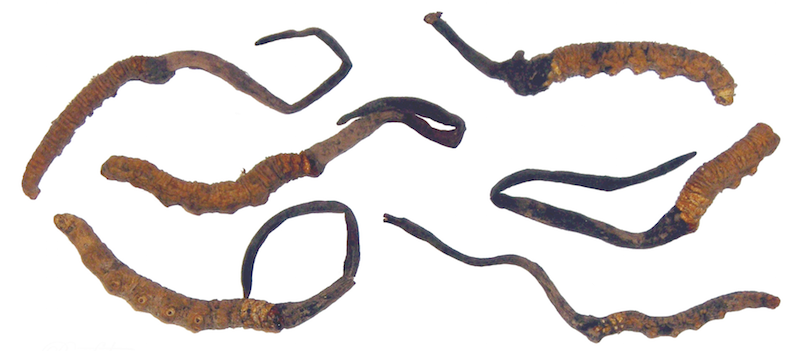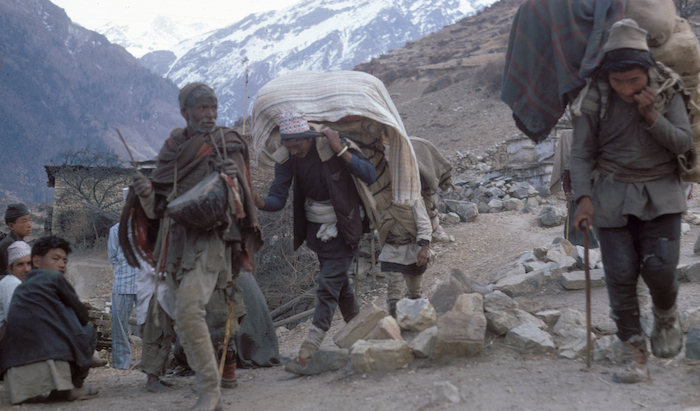This is the fourth in a four-part series of vignettes from the rural Nepalese village of Tarang. You can find the previous three entries here, here, and here. Even if you’ve read them, it’s worth revisiting the pages, as I’ve updated them with great photos of Tarang taken in 1968 by anthropologist James Fisher! This piece looks at a major economic change in the village, and how it can spawn adventures at your table!
In 2011, after a 42-year absence, anthropologist James Fisher returned to Tarang, and found the village a changed place. Some of the changes could have been expected. Cell phones and an airstrip two days downriver has brought Tarang into comparatively close contact with the outside world. Some villagers have moved to Kathmandu and grown wealthy in international trade. But what might be the biggest change was completely unforeseeable.

In the far highlands of Nepal (including around Tarang), there is a caterpillar that lives underground, eating roots. There is also a fungus that infects the caterpillar. It slowly eats the creature alive from the inside, then, come spring, sends up a shoot-like fruiting body. Its name, yarsagumba, translates from Tibetan as “summer grass, winter worm,” because it spends the winter underground inside a caterpillar, then emerges in the spring among the grass.
Yarsagumba was a simple fact of life in Tarang. Then someone discovered the Chinese would pay for it. The fruiting body and the fungus-filled mummified dead caterpillar were supposedly a cure for impotence (and the thousand other miracles these ‘medicines’ are always ascribed), and Chinese consumers couldn’t get enough of them.
It completely changed the economic outlook of Tarangites, especially the poorest. Most families can only spend half of the three months of Yarsagumba season (May-July) on the slopes, as it competes with planting season. But in that time, they can harvest a kilo of yarsagumba, and resell it to a middleman for $4,000. They can spend that money at the trading post two days downriver on things like solar panels and rice. Even the poorest farming family now has about $5,000 tucked away. It’s enough to ensure that disaster and hardship won’t ruin them.
The entire village shuts down during yarsagumba season. Huge chunks of the village up and move to the slopes above. They bring tents and stewpots. The school closes. The children are all with their families on the slopes, and the teachers probably are too. The village is a ghost town, and the slopes are dotted with bright tents and campfires.
Curiously, the windfall hasn’t changed very many people’s lifestyles. A few families now have DVD players, and lots of folks have cell phones. But everyone still lives in the same dark, furniture-less, one-room cottages (albeit perhaps with a single electric light).

At your table, having all the villagers camping in the countryside for a month and a half is a great plot hook. There’s the risk of thieves breaking into houses in the empty village. But there’s also the risk of villagers being preyed upon by monsters. Folks may beg the PCs to slay the beast before the brief harvesting season ends.
The introduction of new wealth may make this quest lucrative for the PCs, especially if they’re hired by a middleman with a serious financial incentive to keep the harvest going. If you take this route, the monster might have been introduced by a rival middleman trying to drive the PCs’ employer out of business so he can raise prices. The rival middleman could even be the monster!
The parasitic nature of the fungus is also interesting. An evil cleric of a disease god might show up incognito in the village to buy all the fungus he can. He’s figuring out how to weaponize it by producing a human-parasitizing version. If the PCs don’t bite on the adventure hook when a pale stranger offers to buy everyone’s yarsagumba at suspiciously good rates, they’ll likely be able to put two and two together a few sessions later when they find a fresh, fungus-filled mummy with a man-sized fruiting body emerging from its head.
–
(This post draws heavily from Trans-Himalayan Traders Transformed by James F. Fisher, the sequel to his earlier Trans-Himalayan Traders: Economy, Society & Culture in Northwest Nepal. He’s a super friendly guy, and asked that I include his email address in the post. It’s jfisher at carleton dot edu)






